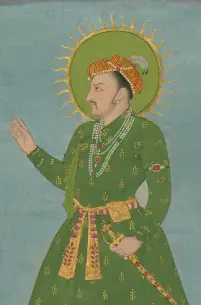(My column in Mint Lounge, October 27 2018)

If ever there was a Mughal ruler who lived the good life, that man was emperor Jahangir, in whose veins flowed Persian, Turkic, and Rajput blood—besides double-distilled spirits and a whole lot of wine. Jahangir, who died on 28 October 1627, was the least militarily inclined of the great Mughals, and though he once led a half-baked rebellion against his illustrious father, he preferred having other men fight the battles that mattered. In an age of violence this was something of a character defect, but Jahangir’s indulgence was a mark of stability in the empire he inherited. Far from the heat and fury of conflict, deep in the embrace of art and aesthetics, he quickly came to represent both self-assured power and the height of Mughal imperial splendour.
Even today, reading the Jahangir Nama is a fascinating exercise. For the figure that emerges is at once pampered prince, curious dilettante, ruthless emperor, and sentimental man. The first-born of Akbar and the so-called Jodha Bai, Shaikhu Baba, as Jahangir was lovingly known, was one upon whom luck bestowed an early blessing. By 18 he was falling in love with his goblet; luckily for him, his brothers were worse. Not even royal commands could move him if he didn’t wish it: once when his father sought to appoint him leader of a campaign, the prince simply absented himself from court. One of those ill-fated brothers accepted the charge, before winning a few battles and losing himself forever to drink. Akbar, meanwhile, turned his hopes toward Jahangir’s son, provoking a hundred intrigues and yet more tragedy.
Shaikhu Baba, however, was too shrewd to drown in wine and die. As Parvati Sharma notes in her sparkling new biography, Jahangir: An Intimate Portrait, he understood quickly what was at stake and where to draw his lines—no son of his could be emperor before he had had his time. So while he continued to drink—pretending after his accession that he only indulged “to promote digestion”—he toned down the quantities. He even presented himself to the orthodox faction as a more pious Muslim than Akbar, to win them over before his favoured son. Of course, having become emperor, he dabbled in more than one religion, till rumours floated that he was a Christian, and he commissioned art in which he appeared cross-legged and shirtless—more Hindu deity than a Muslim sovereign.
Even before his reign, Jahangir was a man of curiosity. All his life, Sharma shows, he went about measuring things—the size of a peach, the weight of a melon, the dimensions of a cave opening—just as he recorded strange and peculiar sights. So while his generals took fire and steel into enemy lands, Jahangir took delight in watching pet cranes mate. He thundered from afar at those enemies (the Marathas he dismissed as “a people of unlimited stupidity”) while investing in a menagerie at home. To please him was to bring him animals: the English gifted him mastiffs, for whom the emperor arranged palanquins. On another occasion he was introduced to a lion that lived with a goat, while his travels threw up everything from a snake swallowing a rabbit to a spider that strangled a snake.
Art flourished under Jahangir. Europeans were delighted with his affection for the Madonna, while Hindus noticed symbols from their own traditions. Then there were images prepared of the oddities that caught the emperor’s eye. Sharma notes the story of an emaciated courtier, thin beyond belief, who asked for leave from court. Jahangir agreed to let him depart—but only after he had his likeness made. A dervish from Sri Lanka, similarly, brought him a slender loris—“really horrible looking”—which the emperor also got painted. Few living beings were left alone: if there was anything that revolted the sovereign of Hindustan, it was worms crawling out of the corpses of animals he’d shot.
Jahangir’s relationship with Nur Jahan, is well recorded, but he was also close to other women. There was a sister to whom he was so attached that his father made him drink her breast-milk so she “may be like a mother to you”. When his wet-nurse died, he carried on his own shoulder one end of her funeral bier. And in the Jahangir Nama are multiple expressions of grief on the death of various imperial women, including, for instance, a Rajput wife, who chose suicide. There is vulnerability to this Jahangir, though another side shows also cruelty, one where interrupting a hunt could cost a servant his life, and a gardener who cut down beloved trees found himself missing a few fingers. Even the elite faced the emperor’s wrath: when a rebellious nobleman was presented, “Were it not for what people would think,” Jahangir fumed, “I would have throttled him with my own hands.”
Of all the Mughal emperors, Jahangir led the most comfortable life, free from problems that afflicted those who ruled before or after him. He packed his 22 years on the throne with the most diverse interests, less focused than Akbar or Dara Shukoh, but rich in its sheer detail. He showed himself a remarkable man, one who could marvel at the gems sent him in tribute, just as he could stun an ambassador by gleefully driving a bullock cart. The future emperor Shahjahan’s propaganda cast Jahangir as a henpecked debauchee. But, as Sharma beautifully shows, and the Jahangir Nama attests, the man was a little bit more: an endearing eccentric but every inch an emperor worth remembering.